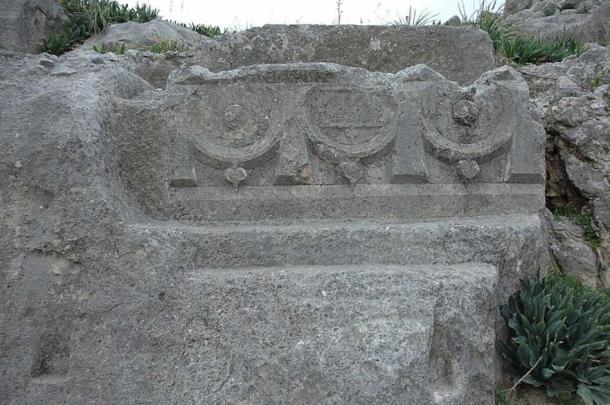
Roman Gladiator Tombs Found By Team of 54 “Dig Hunters” in Turkey
A team of fifty-four specialists in Turkey have been excavating in and around an ancient Roman amphitheater. They recently discovered an ornate burial area devoted to gladiator tombs.
The setting of this discovery is the ancient city of Anavarza. Strategically situated within the borders of present-day Dilekkaya village in southern Turkey, the settlement was founded during the Hellenistic period (323-32 BC). It became a key trading center connecting central Anatolia with Syria.
This was one of the most important cities of Cilicia, an early Roman province annexed to the Roman Republic in 64 BC that remained under Roman rule for several centuries. Anavarza was then one of the important metropolises in all Anatolia. In the 2nd century AD, Anavarza began expanding under the rule of Emperor Septimius Severus. The city eventually became the “Capital of Cilicia” in 408 AD.

An aerial view of the area in ancient Anavarza city where the Roman gladiator tombs were found, note the fallen Roman Hellenistic columns. (Anadolu Agency)
Gladiator Tombs Question The City’s ‘Indestructible’ Moniker
Similarly to the folk that named the Titanic unsinkable, the founders of ancient Anavarza called their settlement “The Indestructible City.” In this instance of speaking too soon, or tempting fate, two major earthquakes in 525 and 561 AD sparked intense plague epidemics that brought the city to its knees. Thereafter, it lost its former importance as a result of constant wars across Anatolia.
- 5 Celebrity Gladiators of Bloodthirsty Ancient Rome
- Gladiators: Ancient Romans Loved Their Deadly Games
According to a report on NTV Anavarza in Cilicia province was most famous for its magnificent defensive gate and ramparts. Furthermore, it was home to the “first double-lane road of the ancient world.” This 2,700-metre-long (8,860-feet-long) and 34-metre (37-yard) wide road, was decorated with 1.5-meter (1.6-yard) high columns.
Now, Turkish archaeologists excavating in the ancient city of Anavarza have unearthed “rare gladiator tombs.”
A 54-Strong Team Of Gladiator Hunters Looking For More
Over the last several years teams of archaeologists have been digging in the Roman amphitheater and the theatre of the ancient city. Anadolu Agency (AA) reported that the “54-strong excavation, includes 30 scientists, 24 general staff and two archaeologists.” The recent digs have been led by Dr. Fatih Gülşen from Çukurova University. Dr Gülşen told AA that his team “found the tombs near the southern part of the excavation site, close to the amphitheater,” where it is believed the gladiators fought.

A previously found unfinished Roman sarcophagus, discovered in the necropolis area of Anavarza, Turkey. (Dosseman / CC BY-SA 4.0)
The lead archaeologist explained that Anavarza covers an area of “1143 decares,” - a decare is equal to 1,000 square meters or approximately 0.25 acres. In this massive ancient space researchers have identified a “castle, mosaics, bathhouses, churches, triumphal arch, aqueducts, and rock tombs, stadium, and ancient theatre.”
However, standing above all of these structures, Gülşen said the amphitheater at Anavarza is special in that it is only “one of the four such examples in Anatolia.”
The Next Discovery Will Hopefully Be Gladiator Skeletons
While the team of archaeologists have now successfully identified where the gladiators’ graves are located, they are yet to put their hands on an actual gladiator bone or skeleton. Gülşen says the team expect to discover the bones of gladiators “and a necropolis” in their planned future excavations.
And when bones are discovered the handheld excavation tools will all be replaced by forensic microscopes and DNA analyzers, as a new team of lab scientists builds maps of where the warriors were raised, trained, and how they met their individual fates.
Where all this will get gory, but fascinating, is when the scientists have to distinguish between gladiatorial wounds. Meaning, the bodies will feature a range of horrific wounds and the scientists have to figure out which are caused by man and steel weapons, and which were inflicted by the jaws and claws of the animals that also fought with gladiators in Roman amphitheaters.
The Term Gladiator, Is Not Actually Correct, Is It?
Written Roman accounts, frescoes and mosaics tell archaeologists and historians that fighters in the arena fought lions, tigers, aurochs, elephants, rhinos, bears, leopards, hippos and bison. Then, we, the public, are told in headlines that “Roman gladiators” fought these animals.
However, it is worth noting that the term “gladiator” is a generalization, and it actually means “swordsman.”
- The Real Lives of Roman Gladiators
- Roman Gladiators Were War Prisoners and Criminals, Not Sporting Heroes
The specific type of Roman men (or women) who fought animals in the arena of death were called “bestiari” or “venators” (beast hunters). While these highly-trained outdoorsmen knew the ways predators moved and fought their prey, they were only lightly armed and not well protected. Hence, this will all get gory, and very interesting, when the gladiator skeletons are unearthed.
Top image: Evidence of gladiator tombs found at the ancient city of Anavarza, which was controlled by the Roman Empire for many years. Over the centuries, Anavarza was either controlled or attacked by the Byzantine Empire, Abbasid Caliphate, and the Mamluks of Egypt. Source: Anadolu Agency
By Ashley Cowie
















Comments
They burned, not buried, bodies back then. Funeral means torch in latin. But something killed a lot of ancients while they slept down in their cavern homes.
Nobody gets paid to tell the truth.